Odekon M. Encyclopedia of paleoclimatology and ancient environments
Подождите немного. Документ загружается.

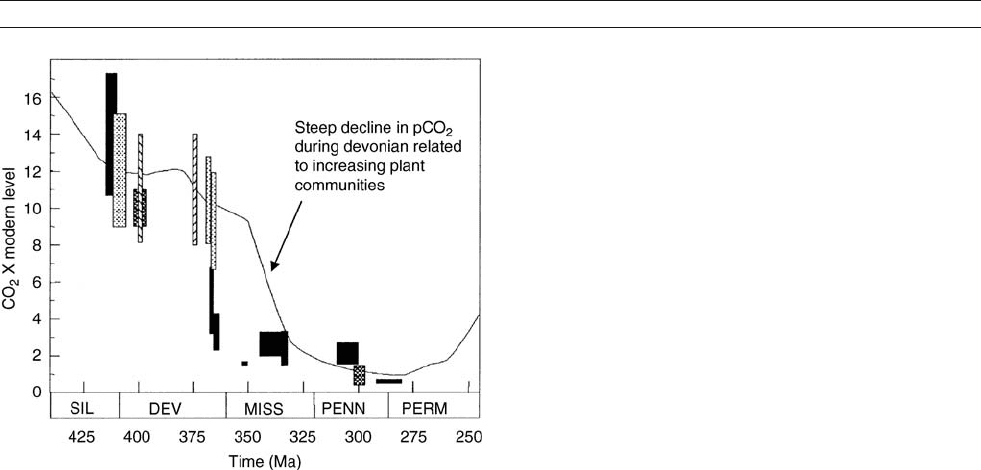
measuring Fe contents and Fe lossesduring weatheringof Precam-
brian paleosols. These investigations have been further expanded
to include other redox-sensitive elements, as well as the ratio of
oxygen demand to demand for CO
2
during weathering (Rye and
Holland, 2000). Other research directions include systematic stu-
dies of root diameter, depth, and density in paleosols, using root
traces, and relating these changes to development of soil morphol-
ogy (Driese and Mora, 2001), widespread deposition of black
shales, and carbon sequestration.
New research directions on pre-quaternary paleosols
Study of pre-Quaternary paleosols appears to be heading in
many future directions. One important research area involves
studies of soil chronosequences (a suite of related soils in
which all soil-forming factors are held constant except for
the time duration of pedogenesis) in order to interpret the
time significance of paleosols in the geologic record (Stiles
et al., 2003). Because paleosols represent unconformities
within otherwise conformable stratigraphic successions, the
ability to resolve time in paleosols is extremely important in
terms of interpreting earth history. U-Pb age-dating of pedo-
genic carbonates offers a promise of improved chronology of
pre-Quaternary paleosols, whose ages place them beyond the
limits of
14
C or other dating methods commonly used for Qua-
ternary paleosols. Applications of paleosol research to interpre-
tations of sequence stratigraphy will help to connect time and
sea level-base level relationships between marine and terrestrial
stratigraphic sections. Careful documentation of continental
traces of invertebrate animals (paleoichnological studies), espe-
cially those relating soil animals and their relationships to soil
forming-processes in the past, is yet another area that is cur-
rently developing.
Steven G. Driese
Bibliography
Caudill, M.R., Driese, S.G., and Mora, C.I., 1996. Preservation of a paleo-
Vertisol and an estimate of Late Mississippian paleoprecipitation. Jour.
Sed. Res., 66,58–70.
Cerling, T.E., 1984. The stable isotopic composition of modern soil carbonate
and its relationship to climate. Earth Planet. Sci. Letters, 71, 229–240.
Cerling, T.E., 1991. Carbon dioxide in the atmosphere: Evidence from Cen-
ozoic and Mesozoic paleosols. Am. J. Sci., 291, 377–400.
Driese, S.G., and Foreman, J.L., 1992. Paleopedology and paleoclimatic
implications of Late Ordovician vertic paleosols, southern Appala-
chians. J. Sed. Petrol., 62,71–83.
Driese, S.G., and Mora, C.I., 2001. Diversification of Siluro-Devonian
plant traces in paleosols and influence on estimates of paleoatmospheric
CO
2
levels. In Gensel, P.G., and Edwards, D. (eds.), Plants invade
the Land: Evolutionary and Environmental Perspectives. New York:
Columbia University Press, pp. 237–253.
Driese, S.G., Mora, C.I., Stiles, C.A., Joeckel, R.M., and Nordt, L.C., 2000.
Mass-balance reconstruction of a modern Vertisol: Implications for
interpretations of geochemistry and burial alteration of paleo Vertisols.
Geoderma, 95, 179–204.
Mack, G.H., James, W.C., and Monger, H.C., 1993. Classification of paleo-
sols. Geol. Soc. Am. Bull., 105, 129–136.
Mora, C.I., Driese, S.G., and Colarusso, L.A., 1996. Middle to Late Paleo-
zoic atmospheric CO
2
from soil carbonate and organic matter. Science,
271, 1105–1107.
Mora, C.I., and Driese, S.G., 1999. Palaeoclimatic significance and stable
carbon isotopes of Palaeozoic red bed paleosols, Appalachian Basin,
USA and Canada. In Thiry , M., and Simon-Coinçon, R. (eds.), Palaeo-
weathering, Palaeosurfaces and related Continental Deposits. International
Association of Sedimentologists Special Publication No. 27, pp. 61–84.
Retallack, G.J., 1988. Field recognition of paleosols. In Reinhardt, J., and
Sigleo, W.R. (eds.), Paleosols and Weathering Through Geologic Time.
Boulder, CO: Geological Society of America. GSA Special Paper 216,
pp. 1–20.
Retallack, G.J., 1991. Untangling the effects of burial alteration and ancient
soil formation. Ann. Rev. Earth Planet. Sci., 19, 183–206.
Retallack, G.J., 2001. Soils of the Past: An Introduction to Paleopedology,
(2nd ed.). Oxford: Blackwell Science, 416pp.
Rye, R., and Holland, H.D., 2000. Geology and geochemistry of paleosols
developed on the Hekpoort Basalt, Pretoria Group, South Africa. Am. J.
Sci., 300,85–141.
Sheldon, N.D., Retallack, G.J., and Tanaka, S., 2002. Geochemical climo-
functions from North American soils and application to paleosols
across the Eocene-Oligocene Boundary in Oregon. J. Geol., 110, 687–696.
Stiles, C.A., Mora, C.I., and Driese, S.G., 2001. Pedogenic iron-manganese
nodules in Vertisols: A new proxy for paleoprecipitation? Geology, 29,
943–946.
Stiles, C.A., Mora, C.I., Driese, S.G., and Robinson, A.C., 2003. Distinguish-
ing climate and time in the soil record: Mass-balance trends in Vertisols
from the Texas Gulf Coastal Prairie. Geology, 31, 331–334.
Cross-references
Atmospheric Evolution, Earth
Carbon isotope Variations Over Geologic Time
Carbon Isotopes, Stable
Early Paleozoic Climates (Cambrian-Devonian)
Geochemical Proxies (non-isotopic)
Late Paleozoic Paleoclimates (Carboniferous-Permian)
Mesozoic Climates
Mineral Indicators of Past Climates
Oxygen Isotopes
Paleoclimate Proxies, an Introduction
Paleo-Precipitation Indicators
Paleosols–Quaternary
Stable Isotope Analysis
Figure P33 Estimates of middle to late Paleozoic atmospheric CO
2
levels (expressed as times present atmospheric level) derived from
Appalachian basin paleosols (closed symbols from Mora et al., 1996;
other sources (patterned symbols) of pedogenic carbonate-based
estimates cited in Driese and Mora, 2001), calculated using the soil
carbonate carbon isotope paleobarometer (Cerling, 1991). Other
proxy-based estimates include stomatal density (open symbols) and
carbon mass-balance model (line; see discussion in Driese and
Mora (2001)).
PALEOSOLS, PRE-QUATERNARY 751
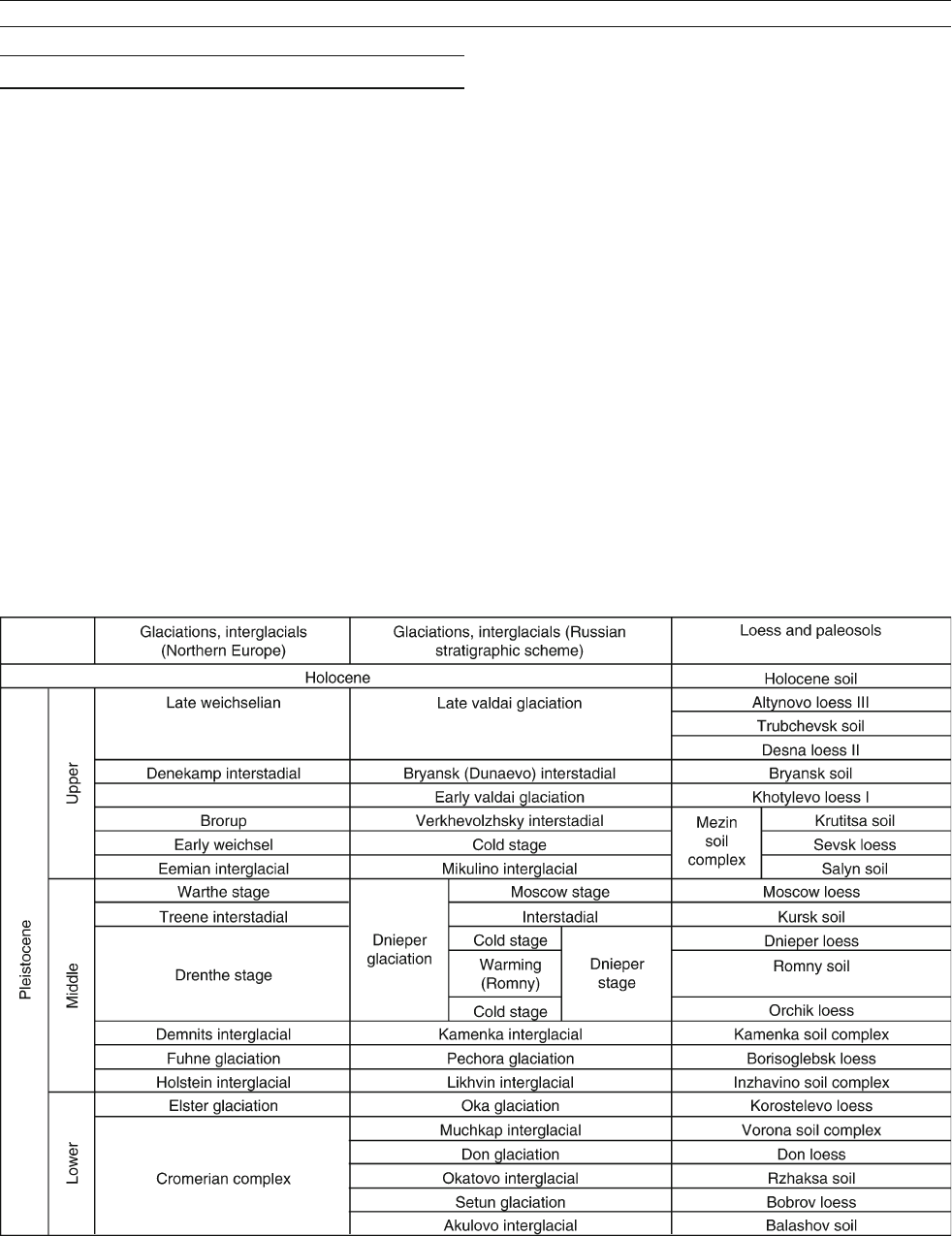
PALEOSOLS, QUATERNARY
Introduction
Paleosols, the remains of former soil covers of the Earth now
buried under younger deposits, are an important testimony of the
environmental conditions of ancient epochs. Paleosols occur in
sediment sequences of various origins, such as alluvial sediments
of river terraces, and in shallow marine (lagoon), volcanic, and
even glacial deposits. However, the most widespread and best-
preserved paleosols occur in loess deposits. The buried soils are
detected on all continents except for the Antarctic. The first half
of the twentieth century was the period of upbuilding data about
paleosols in loess sequences. It was established that paleosols
contain very important information on chronostratigraphy and
paleogeography.
Paleosols as a chronostratigraphic component
of the Pleistocene
The horizons of paleosols are widely used as key horizons for
the stratigraphic subdivision of continental sedimentary series.
Frequently located in the periglacial zone and occupying an inter-
mediate position between regions of moraine distribution on the
one hand, and marine deposits on the other hand, horizons of
buried soils represent an important link in a system of general cor-
relation of events in glacial, periglacial, and maritime areas.
The reliability of usage of paleopedologic data has increased,
especially with the development of methods of absolute and rela-
tive dating: radiocarbon, thermoluminescent, paleomagnetic,
amino acid, and paleontological (palynological and paleofaunis-
tic). The use of paleosols as components of the stratigraphic record
has increased, especially after paleosols morphotypical features of
different ages were studied (Figure P34).
Paleosols in various sediment sections were once compound
units of soil covers of different ages. The possibility of their use
as a reliable tool for chronostratigraphic subdivision and correla-
tion is based upon the fact that each of the interglacial epochs of
the Quaternary soil formation was characterized by intrinsic fea-
tures of pedogenesis, combinations of paleosols in automorphic
conditions, and specific features of their geographic distribution.
These include, for example, soil complexes that belong to the
late Pleistocene (Sangamon) interglacial in North America, to
the Eemian interglacial in West Europe, to the Mikulino (East
Europe), and to the Kazantsevo interglacial in Siberia. Such
paleosols were named ‘‘soil stratigraphic units’’ or ‘‘pedostratigra-
phic units’’ (Catt, 1990). For these, R. Morrison (1967) has sug-
gested the term ‘‘geosol.’’ Not only interglacial soils can be used
as stratigraphic markers. Interstadial Pleistocene soils having
regional names (e.g., Kesselt, Gleina, Stilfrid B, and Mende F in
West Europe; the Bryansk soil in East Europe; Farmdale in North
America) with established genetic connections and age control
based on radiocarbon dating (32–24 ky
BP) can also be used for
distant correlations.
Figure P34 The Pleistocene sequence of the East European Plain.
752 PALEOSOLS, QUATERNARY
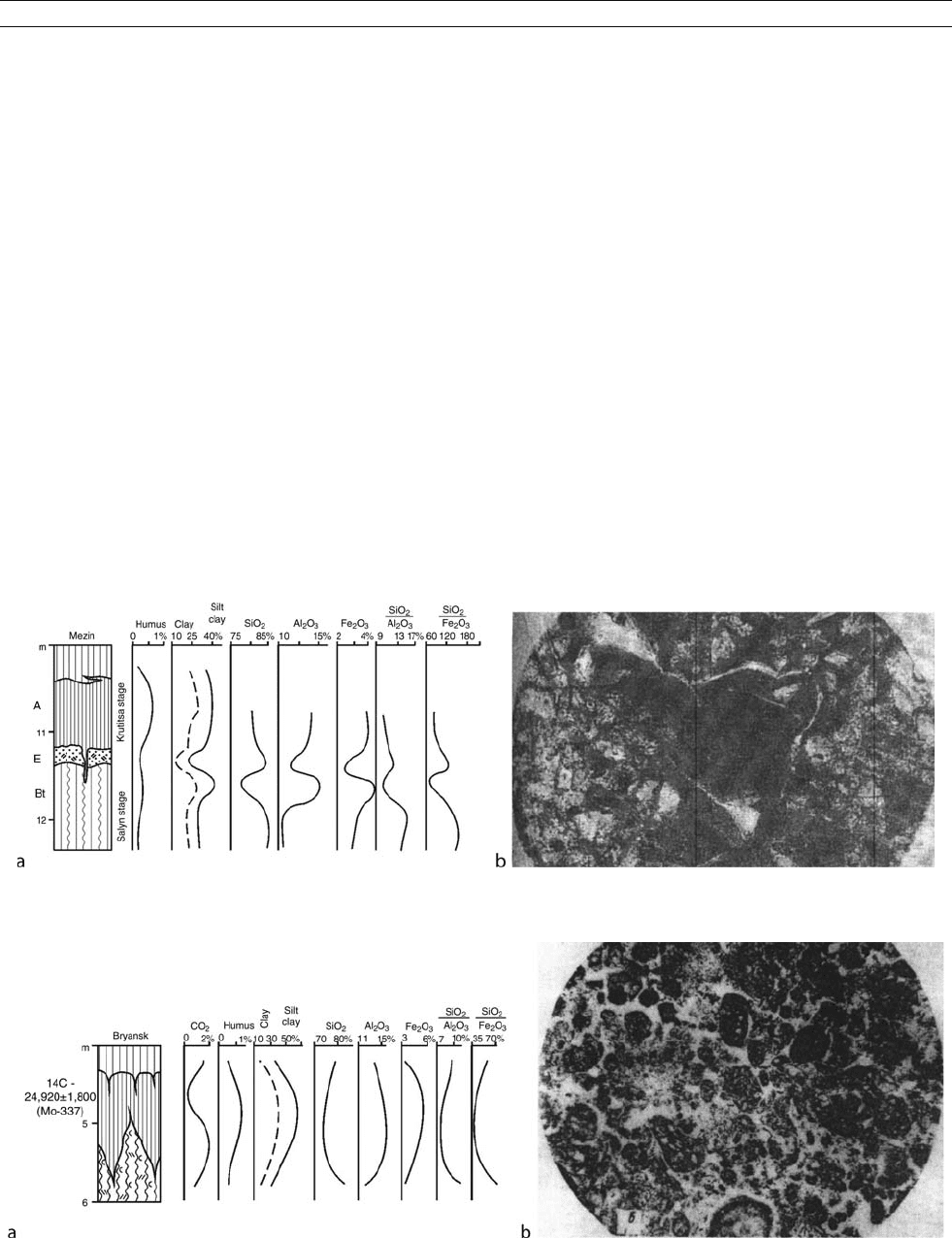
Diagnostic methods of paleosol genesis
The main aim of paleopedological studies is to reconstruct genetic
paleosol profiles and to identify the soil formation factors. The
structure of a soil profile can therefore be used for paleopedologic
reconstructions.
Consequently, analysis of a paleosol in the field starts with
a detailed description of its genetic profile on well-cleaned
walls of natural exposures – those of open pits, ravines, river
banks, marine coasts, and others.
Paleosols contain much more information on the relevant pro-
cesses, which occurred at different times and affected not only the
formation of the soil profiles, as such, but also their preservation.
We can distinguish the following main processes responsible for
the formation of the buried soils observed in loess-paleosol for-
mations (where the best preserved paleosols are found):
1. Processes of soil formation, which took place during periods
of intensive pedogenesis in warm semicycles of glacial-
interglacial cycles. Their direction and intensity changed in
response to different environmental-climatic conditions.
2. Processes specific to transitional stages to cold semicycles and
to glacial ones. These specific processes, which took place at
the end of or at the completion of soil formation during warm
semicycles, greatly affected the preservation of soil of profiles,
especially their upper parts that were marginal to the overlap-
ping loess horizons. Cryogenic processes that contributed to
distortion of soil horizons include processes of sedimentation
intensification, when intermediate deposits transitional from
fossil soils to loess horizons were formed between loess and
soil, and removal and re-deposition processes that affected
materials in the upper parts of fossil soils located on slopes (for-
mation of so-called pedosediments).
3. Pedometamorphic (after Gerasimov, 1971) or diagenetic
processes that transformed the buried fossil soils. As a result
of these processes, fossil soils lost their indices of low stabi-
lity and acquired new secondary ones.
In studying the genesis of fossil soils, the greatest attention is
naturally paid to indices of pedogenesis stages, which reflect con-
ditions extant when the soils proper were formed. These processes
lie at the base of paleopedologic reconstructions. However, study
of the different forms of disturbances of the soil profile and of ped-
ometamorphic changes in their properties is also very important.
The set of analytic methods that we use in our studies
depends on the preservation of the most stable indices of soil
formation. They include the following:
Analytical methods for studying the mineral componen ts
of soils
Data from chemical and physical-chemical analyses, including
particle-size (granulometric) analysis, total chemical composition,
clay minerals, and others can be used for diagnostic purposes
(Figure P35a and P36a). In a number of cases, however,
when fossil soils have been subjected to the impact of secondary
Figure P35 (a) Analytical data of Mezin paleosol complex, Mezin section, Dnieper basin; (b) Clay illuviation coating in Bt horizon.
Figure P36 (a) Analytical data of the Bryansk interstadial paleosol, Bryansk section, Dnieper basin; (b) Ooid type of microstructure (humus horizon).
PALEOSOLS, QUATERNARY 753

cryogenesis and fracturing, their genetic horizons may appear to
be mixed, and the data of the distribution of mineral components
along their profiles may be greatly distorted.
Analytical methods for investigating organic matter
The composition and characteristics of organic matter in the
soil are the most important diagnostic criteria of soil formation
processes. Soils show differences in their humus content depend-
ing on natural climatic conditions. The fractional composition of
soils, the properties of their humic acids, and the regularities of
humus distribution along this profile all change as well.
When the soil is buried, the amount of organic matter it
contains decreases noticeably in spite of the fact that the soil
preserves its dark color. Analyses of radiocarbon data on the
ages of different fractions of humus indicate that fractions of
the humic acids proper and the humic acids of humins are
the most of stable and the least subject to pedometamorphic
transformation (Gerasimov and Chichagova, 1971). Numerous
studies have confirmed the hypothesis, first advanced by I. P.
Gerasimov, who suggested that the correlation of the main
groups of humic matters (humic and fulvic acids, humins) in
fossil soils generally reflects two main directions in the forma-
tion of paleosols: the forest and steppe types.
The data on some properties of humic acids (optical density,
stability to electrolytes) are also used as diagnostic indicators
of former pedogenesis. This was demonstrated for the first time
in the study of humic acids in soils of the Bryansk interval and
of the Mikulino interglacial (Morozova and Chichagova, 1979).
Micromorphological method
This method, developed by W. L. Kubiena (1970), is widely
used for the study of fossil soils in different countries (Fedoroff,
1971; Bronger, 1972; Smolikova, 1972; Konecka-Betley, 1979;
Morozova, 1981; Matviishina, 1982; Mucher and Morozova,
1983; Catt, 1990; and others). The micromorphological method
permits us to study those details of the soil profile that contain
the basic information both on processes of the old pedogenesis,
and on those that resulted from soil fossilization and that disturbed
its overall structure.
As micromorphological diagnostics of soils, the following are
used: data about microstructure (aggregation and voids), grade
of pedality (degree of aggregation; Bullock et al., 1985), ground-
mass (b-fabric), pedofeatures, and other features (Figure P35b
and P36b).
To define paleosols, the paleoactualistic principle is applied:
paleosol properties are compared to the properties of modern soils,
and their genesis is inferred on the basis of their commonality.
Micromorphological research using these materials is presented
in the works of Kubiena (1970) and Bullock et al. (1985). Genetic
types of paleosols are named according to International (FAO)
system and its correlation with the Russian system of soil classifi-
cation (Gerasimova et al., 1996).
Evolution of soil formation in the Quaternary period
Quaternary types of soil formation epochs
The difference in heat and moisture supply between phases of the
climatic macrocycles of the Pleistocene controlled succession of
soil formation types, and various patterns of soil zonality, under
changing conditions of sedimentation and lithogenesis through
macrocycles.
Interglacial soil formation. This soil type developed during
the thermal optimum of the climatic macrocycle. Interglacial
paleosols either corresponded by their genesis to modern soils in
the considered territory or were formed against the background
of a warmer and wetter climate. At temperate latitudes, over the
vast spaces of large watersheds, a latitudinal soil zonality was
developed. In the late and middle Pleistocene, cambisols, luvic
cambisols, stagnic podzol-luvisols (pseudogleys), luvisols, phaeo-
zems, and chernozems were formed. During the early Pleistocene
warm epoch (Cromer), paleosols with subtropical features of
pedogenesis were formed.
Interstadial soil formation. During the cold semicycle,
drastic landscape-climatic changes occurred. These were
accompanied by climatic oscillations of heat and moisture
supply, both of a stadial and interstadial nature, as reflected in
the processes of soil formation and sedimentation.
Interstadial soil formation was characterized by two main
types of paleosols. The first was typified by predominance of
paleosols of the cryo-gley genesis (gelic gleysols). For example,
in the Bryansk (Farmdale) epoch, the gleyezems were widespread
in west and middle Europe, on the southwestern margins of the
East European Plain, and in some regions of North America.
Gleyezems were characterized by the development of gleyzation
processes (i.e., water logged, anaerobic conditions), weakly devel-
oped pedality, and massive microstructures. Paleosols with aggre-
gates of ooid type have been identified in the central regions of the
East European Plain.
The second type differed from the interglacial paleosols by
greater uniformity in the manifestation of soil-forming processes,
with humus accumulation predominant among them. Pedality
was moderately developed, with aggregation and plasma clay-
humus. The latitudinal zonality was then essentially simplified,
becoming nearly hyperzonal. Interstadial soils of early glacial
stages (such as the Krutitsa soil of the Mezin complex) belong
to that type.
Pleniglacial soil formation corresponded to the maximum of
the cold phase of a semicycle. During this time, permafrost was
widespread beyond the ice-sheet in the periglacial zone. Sedi-
mentation was dominant over pedogenesis. Overall, the biogeo-
chemical processes of rock breakdown were overwhelmed, and
specific synlithogenic paleosols (loesses) were formed. These
processes can be compared to those characteristic for the gray
soils of semideserts, to some extent. Very low-intensity soil for-
mation occurred during slightly wetter phases; it was mani-
fested in the processes of gleyization, segregation of ferric
hydroxides, and discrete humification.
General features of the pedogenesis in the Quaternary
period
The nature of soil formation did not repeat itself, but changed
consistently due to the overall trend of climatic changes. In gen-
eral, interglacial soil formation within the middle latitudes of the
Northern Hemisphere (the present-day temperate belt) changed
from subtropical (Mediterranean) in the early stages of the Pleisto-
cene up to subboreal (boreal) at its termination. These changes
have been established based on genetic types of the interglacial
paleosols known from the loess sections of North America,
Europe, and Asia (West Siberia, and China).
Evolution of soil formation processes in the Quaternary
and their climatic interpretation (based on the example
of the central East European Plain)
At present, soddy podzols and gray forest soils in combination
with leached chernozems of the meadow steppe occur in the
central regions of the East European Plain. The main cli-
matic parameters of this territory are: t
1
= –10
C, t
7
=+18
C,
754 PALEOSOLS, QUATERNARY
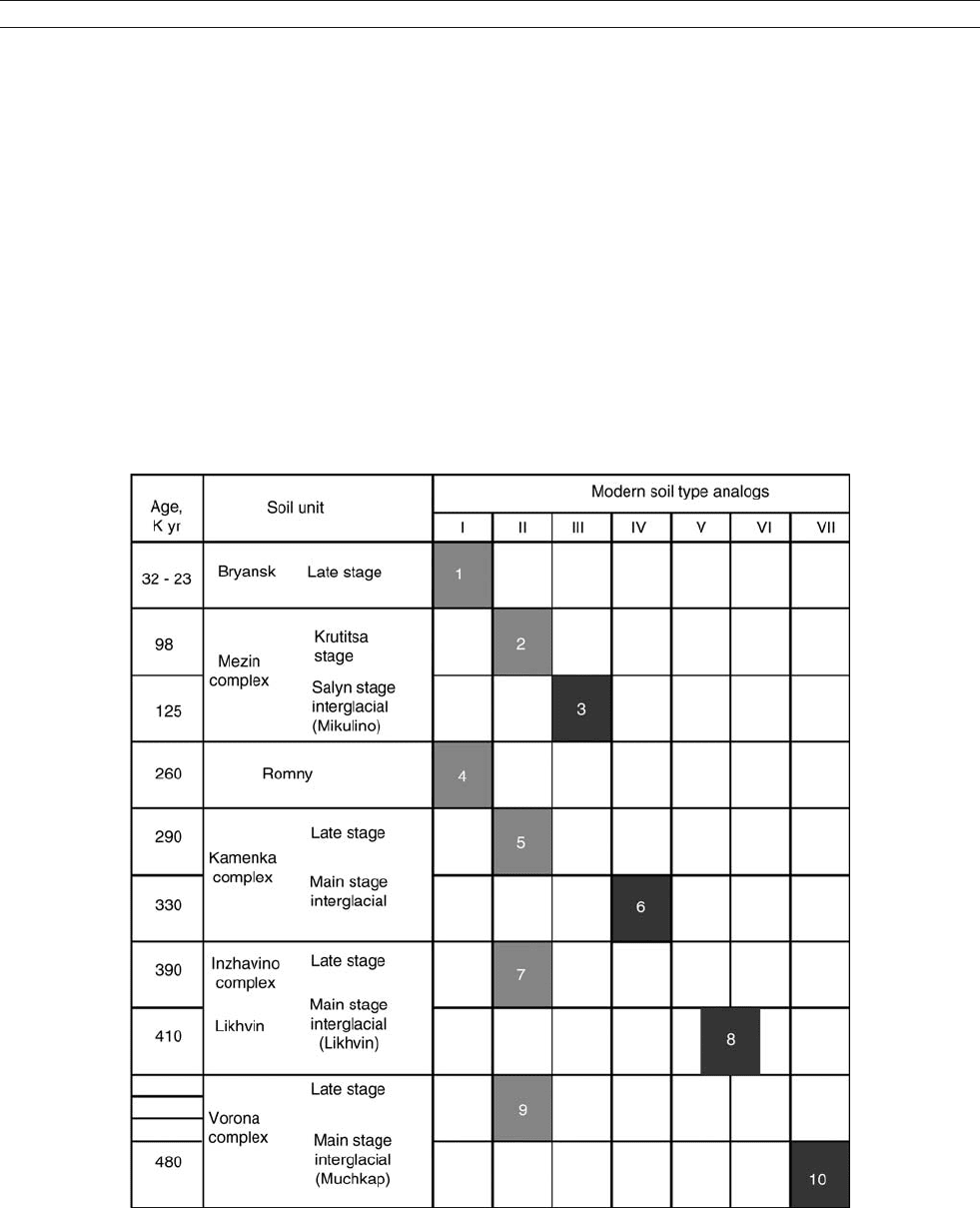
t
yr
=+8
C, P
yr
=550–600 mm, where t
1
= average January
temperature, t
7
= average July temperature, t
yr
= annual mean tem-
perature, and P
yr
= annual mean precipitation.
The loess-soil series in this region are the most studied
(Figure P37). Here, it is possible to observe changes in interglacial
soil formation during the last million years. The earliest known
interglacial soils are the paleosols of two climatic macro-
cycles prior to the Brunhes-Matuyama (780 ky
BP) paleomagnetic
boundary.
During the period when the oldest fossil soils studied were
formed (the Balashovskaya paleosol, in the Matuyama zone),
the type of pedogenesis with well-expressed subtropical fea-
tures dominated. For this time, two types of paleosol profiles
are established. One of them corresponded to wet subtropical
conditions due to a texture-differentiated structure of the profile
and presence of braunlehm plasma (containing fragments of
illustrated coatings in finely dispersed clay; Kubiena, 1970)in
the Bt horizon. In the second type, the features of rubefication
and ferruginization (reddening of soil due to iron oxide accu-
mulation) of the soil plasma are established.
During the Okatovo interglacial, when the Rzhaksa soil
formed, phaeozems appeared in this region (Figure P34). The
Vorona (Muchkap) interglacial (the late Cromer) had set in
after the Don glaciation. Polygenetic soils from less than two
contiguous paleosols were detected in the soil cover. The soils
of the main stage of soil formation were represented by phaeo-
zems in combination with luvic cambisols. For this stage, the
following climatic parameters (average values) have been
reconstructed based on soil types: t
1
=0
C, t
7
= +23
C,
t
yr
= +12
C, P
yr
= 800–900 mm.
During the main phase of the Inzhavino epoch of soil for-
mation, corresponding to the Likhvin (Holstein) interglacial,
pedogenesis occurred under conditions of the subboreal forest
zone. The forest soils that had a genetically differentiated
profile of eluvial-illuvial type, with traces of surface gleyization,
were widespread (luvic cambisols, with participation of stagnic
Figure P37 Quaternary evolution of central part of East European Plain. Modern soil type analogs: I – gelic gleysols, gelic podzoluvisols;
II – chernozem-like sols of cold steppe and forest steppe; III – luvisols; IV – luvisols with participation cambisols; V–VI – cambisols with participation
of luvisols and stagnic podzoluvisols; VII – phaeozems with participation of cambisols. Area of distribution of modern soil type analogs: 1 – upstream
basin of Lena river; 2, 5, 7, 9 – intermountain depressions of Central Altay; 3 – northern part of West and Central Europe; 4 –North of western Siberia;
6 – upstream basin of Visla river; 8 – upstream basins of Rhine and Danube rivers; 10 – intermountain depression of Danube midstream.
PALEOSOLS, QUATERNARY 755
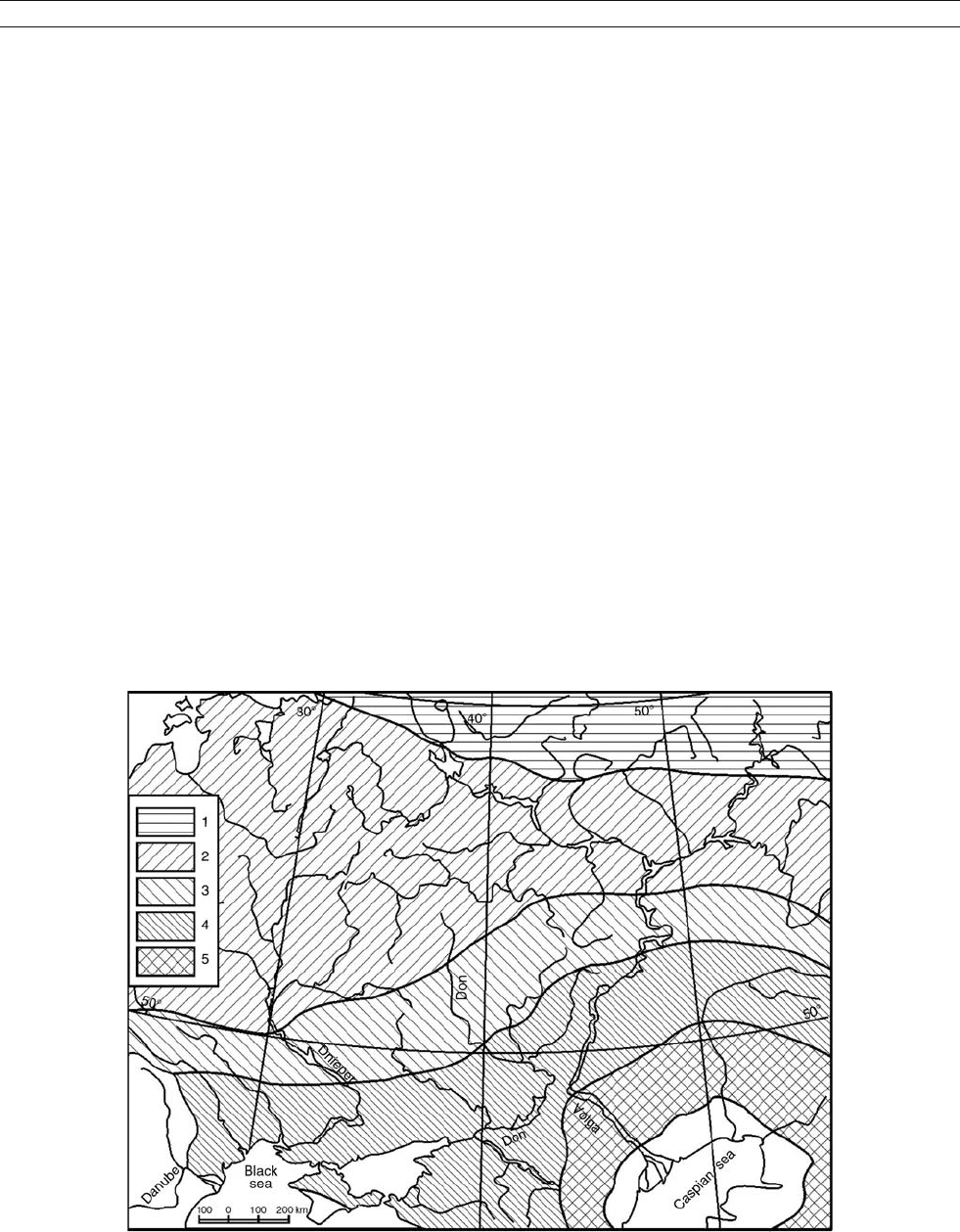
podzoluvisols). The modern analogs of these fossil soils are now
widespread in West Europe, in the upper reaches of the Rhine
and Danube rivers. The reconstructed climatic parameters for
the Likhvin interglacial based on the paleopedologic data are:
t
1
=0
C, t
7
=+21
C, t
yr
=10
C, P
yr
= –700 to 750 mm.
During the main phase of the Kamenka (Demnitz) intergla-
cial period of soil formation, the forest soils dominated. These
soils can be attributed to luvic cambisols and cambisols. Simi-
lar forest soils are now widespread in West Europe and in
the south of central Europe, in particular, in the upper reaches
of the Vistula River. For the Kamenka interglacial, the
following climatic parameters are reconstructed: t
1
= –1
C,
t
7
= +21
C, t
yr
=+9
C, P
yr
= 600–700 mm.
Apparently, it is possible to consider the tundra-gley soil or
gelic gleysols as a modern analog of soils of the Romny inter-
val (Dnieper glaciation; Figure P32). The soils have a profile
A1g-Cg. Near the upper contact of the Romny soil, the
festoon-like cryogenic deformations are described. Their ana-
logs can be found in similar formations of the modern active
layer of permafrost in the western Yamal Peninsula. It is possi-
ble to assume that the modern analogs of the Romny intersta-
dial paleosols lay within the limits of the West Siberian
tundra. The climatic parameters of this interstadial based
on paleopedologic data average: t
1
= –26
C, t
7
= +13
C,
t
yr
= –6
C, P
yr
= 250–350 mm.
At the base of the late Pleistocene loess-soil series, the poly-
genetic Mezin complex occurs. Its early phase (Salyn) corre-
sponds to the Mikulino (Eemian, Sangamon) interglacial,
the late phase to the Krutitsy (Brorup) interstadial. The soils
of the Mikulino (Eemian) interglacial were formed in condi-
tions corresponding to the forest zone of the subboreal belt.
They are represented by paleosols with the distinct texture-
differentiated profile A-E-Bt-C. The Bt horizon is characterized
by abundance of illuviation coatings, testifying to participation
of inwashing processes (illuviation of clay) in the soil forma-
tion. As modern analogs of the Mikulino interglacial soils,
one can consider luvisols, which comprise the present soil
cover in the north of central and middle Europe. Climatic
parameters of the Mikulino interglacial based on the paleope-
dological data are as follows: t
1
=+1
C, t
7
= +17
C,
t
yr
=+9
C, P
yr
= 600–650 mm. For this interglacial, small-
scale maps of the soil cover of Europe and of the East
European Plain were compiled (Figure P38).
Soils of the Krutitsy interstadial had a genetic profile A1-
AB-C. The chernozem-like soils under the meadow-steppe
vegetation or open larch woodlands in the intermountain
depressions of Central Altai can be considered as their modern
analogs. The reconstructed climatic parameters are: t
1
= –7
C,
t
7
= +15
C, t
yr
= –0.5
C, P
yr
= 220–450 mm.
It is necessary to note that the interglacial soil formation of
the middle and, probably early Pleistocene, apparently included
the concluding phases of interstadials of subsequent glacia-
tions, when the soils, similar to those of the Krutitsy intersta-
dial, were formed.
In the concluding phase of the Bryansk interstadial (corre-
lated with the middle Valdai, Denekamp interstadial) soil for-
mation took place under the conditions of the polar belt. The
soils are identified as tundra-gley (gelic gleysols), with charac-
teristic features of these paleosols being strong gleyzation of
the entire profile (Ag-Bg-Cg), and a particular ooid aggre-
gation. An area of modern analogs of these paleosols lies
within the upper Lena River basin. The reconstructed climatic
Figure P38 Mikulino interglacial soil map of East European Plain (central and south part); 1 – podzoluvisols; 2 – luvisols of broadleaf forests;
3 – luvic chernozems and gleyic chernozem of forest-steppe; 4 – chernozems of grass steppe; 5 – kastanozems of grass steppe.
756 PALEOSOLS, QUATERNARY

parameters of the Bryansk interstadial (average values) are:
t
1
= –23
C, t
7
= +13
C, t
yr
= –6
C, P
yr
= 150–250 mm.
The peak of the late Valdai glaciation (20–18 ky
BP), corre-
sponding to the Last Glacial Maximum, was the main climatic
minimum of the Cenozoic (Velichko, 1973). At this time, a vast
periglacial zone stretched. Beyond the Scandinavian Ice Sheet, a
considerable portion of this zone (up to 47–48%) was occupied
by permafrost (Velichko, 1982). In this region, peculiar synlitho-
genic paleosols of pleniglacial type occurred. These were chara-
cterized by slow humus accumulation, microaggregation, and
accumulation and re-distribution of secondary carbonates without
their leaching. The reconstructed climatic parameters inferred
from paleocryogenic structures of this time are: t
1
= –25 to
30
C, t
7
=+12
C, t
yr
= –9
C, P
yr
=250–300 mm.
At the Pleistocene/Holocene transition, the permafrost
boundary retreated to 54–55
N. Within the loess periglacial
regions, thermokarst processes of the ground ice melting
took place, along with formation of a specific complex of land-
forms – the relic cryogenic microrelief (RCM) (Velichko,
1973). RCM strongly influenced the structure of the Holocene
soil cover. Within the range of the light-gray and soddy podzo-
lic soils of the central Russian Plain, the small-contour differen-
tiation of soils is represented by the combination of the eroded
hummocky soils in place of polygonal blocks, and the meadow
soils in the troughs and depressions in place of the melted out
ice-veins of the Yaroslavl’ cryogenic stage. The meadow soils
were formed during the optimum phase of the Holocene and
were preserved in the form of the relic second humus horizon
in genetic profiles of modern soddy-podzolic and gray forest
soils (Velichko et al., 1996).
Conclusion
During the Quaternary, abrupt changes took place in the direc-
tion and intensity of pedogenesis, corresponding to glacial-
interglacial climate cycles and general trend. According to
these changes, three main types of soil-formation epochs are
distinguished: interglacial, interstadial, and pleniglacial (gla-
cial). Within the macrocycles, all three types of pedogenesis
occur. Due to the general trend of climate change, the soil
formation process changed from subtropical type in the early
phases of the Pleistocene to polar types in its final stages.
Tatiana D. Morozova and Andrei A. Velichko
Bibliography
Bronger, A., 1972. Zur Mikromorphologie und Palaoboden aus Loss in
Karpatenbecken. In St. Kowalinsky (ed.), Soil Micromorphology. Wars-
zawa, Poland: Naukowe, pp. 607–615.
Bullock, P., Fedoroff, N., Jongerius, A., Stoops, G., and Tursina, T.V.,
1985. Handbook for Soil Thin Sections Description. Wolverhampton,
UK: Waine Research Publications, 152pp.
Catt, J. (ed.), 1990. Paleopedological manual. Quaternary Int., 6,1–95.
Fedoroff, N., 1971. The usefulness of micromorphology in paleopedology.
In Vaalon, D.R. (ed.), Paleopedology. Origin, Nature and Dating
of Paleosols. Jerusalem, Israel: Israel University Press, pp. 156–160.
Gerasimov, I.P., 1971. Nature and originality of paleosol. In Vaalon D.R.
(ed.), Paleopedology. Origin, Nature and Dating of Paleosols.
Jerusalem, Israel: Israel University Press, pp. 15–27.
Gerasimov, I.P., and Chichagova, O.A., 1971. Nekotorie voprosy
radiouglerodnogo datirovaniya gumusa. In Pochvovedenie, vol. 10.
pp. 3–11.
Gerasimova, M.I., Gubin, S.V., and Shoba, S.A., 1996. Soil of Russia and
Adjacent Countries. In Suiedema R., (ed.), Geography and Micromor-
phology. Moskow-Wagenningen, 204pp.
Konecka-Betley, K., 1979. Reliktowe procesy glebotworcze w glebach
wspolczesnych wytworrzonych z gleny zwalowej. Zeszyty Naukowe
Szkoly Glownej Gospodarstwa Wiejskiego Akademii Rolniszej
w Warszawie. Rolnictwo, 18, pp. 78–97.
Kubiena, W.L., 1970. Micromorphological Features of Soil Geography.
New Brunswick, NJ: Rutgers University Press, 255pp.
Matviishina, Zh.N., 1982. Micromorfology of Pleistocene Soils of the
Ukraine. Kiev, Ukraine: Naukova Dumka, p. 174.
Morozova, T.D., 1981. Razvitie Pochvennogo Pokrova Evropy v Pozdnem
Pleistotsene. Moscow, Russia: Nauka, p. 231.
Morozova, T.D., and Chichagova, O.A., 1979. Peculiarities of organoc mat-
ter of fossil soils in connection with genesis and diagenesis.
In: Vassoevich, N., (ed.), Organicheskoe veshestvo v sovremennyh I isko-
poemyh osadkah (sedikakhity), Moscow, Russia: Izd. Mosk. Univ., pp.
68–69.
Morrison, R.B., 1967. Principles soil of Quaternary stratigraphic. In
Morrison, R.B., and Wright, H.E. (eds.), Quaternary Soils. Proc. VII
INQUA Congress, vol. 9, Denvez, Colozado, USA. pp. 1–69.
Mucher, H.I., and Morozova, T.D., 1983. The application of soil micro-
morphology in Quaternary geology and geomorphology. In Bullock
and Murphy, G.P. (eds.), Soil Micromorphology, vol. 1. Berkamsted,
UK: A.B. Acad. Publ., pp. 151–194.
Smolikova, L., 1972. The significance of soil micromorphology for
the solutions of soil evolution in the geology of quaternary. In St.
Kowalinsky, (ed.), Soil Micromorphology. Warszawa, Poland: Naukowe,
pp.543–557.
Velichko, A.A., 1973. Prirodnyi Process v Pleistitsene. Moskow, Russia:
Nauka, p. 265.
Velichko, A.A., 1982. Main features of the last climatic macrocycle and the
present state of environments. In Gerasimov, I.P., and Velichko, A.A.
(eds.), Paleogeography of Europe during the last hundred thousand
years (Atlas-Monograph). Moscow, Russia: Nauka Press, pp. 139–144.
Velichko, A.A., Morozova, T.D., Nechaev, V.P., Poroshnyakova, O.M.,
1996. Paleogenesis, Soil Cover and Agriculture. Moscow, Russia:
Nauka Press, p. 151.
Cross-references
Eemian (Sangamonian) Interglacial
Encyclopedia of Soil Science and Technology
Interstadials
Last Glacial Maximum
Loess Deposits
Pleistocene Climates
Quaternary Climate Transitions and Cycles
Wisconsinan (Weichselian, Würm) Glaciation
PALEOTEMPERATURES AND PROXY
RECONSTRUCTIONS
Introduction
Earth’s global temperature is mainly a function of energy derived
from incoming solar radiation (insolation) of varying wave-
lengths, with a very minor energy input coming from geothermal
processes. About 28% of the total incoming insolation is reflected
back to space by clouds, particles and molecules in the atmo-
sphere, about 25% is absorbed in the atmosphere by ozone, clouds
and water vapor, and about 47% is absorbed at the Earth’ssurface.
Of this 47%, about 18% is reflected to back to space, while the
remainder heats the atmosphere through latentheating(conversion
of water to water vapor), convection, and absorption of infrared
radiation by greenhouse gases. This trapping of solar energy by
the atmosphere is why the Earth’s mean annual temperature is
33
C warmer than it would be otherwise and the main reason
there is concern about future global warming caused by anthropo-
genic greenhouse gas emissions.
PALEOTEMPERATURES AND PROXY RECONSTRUCTIONS 757
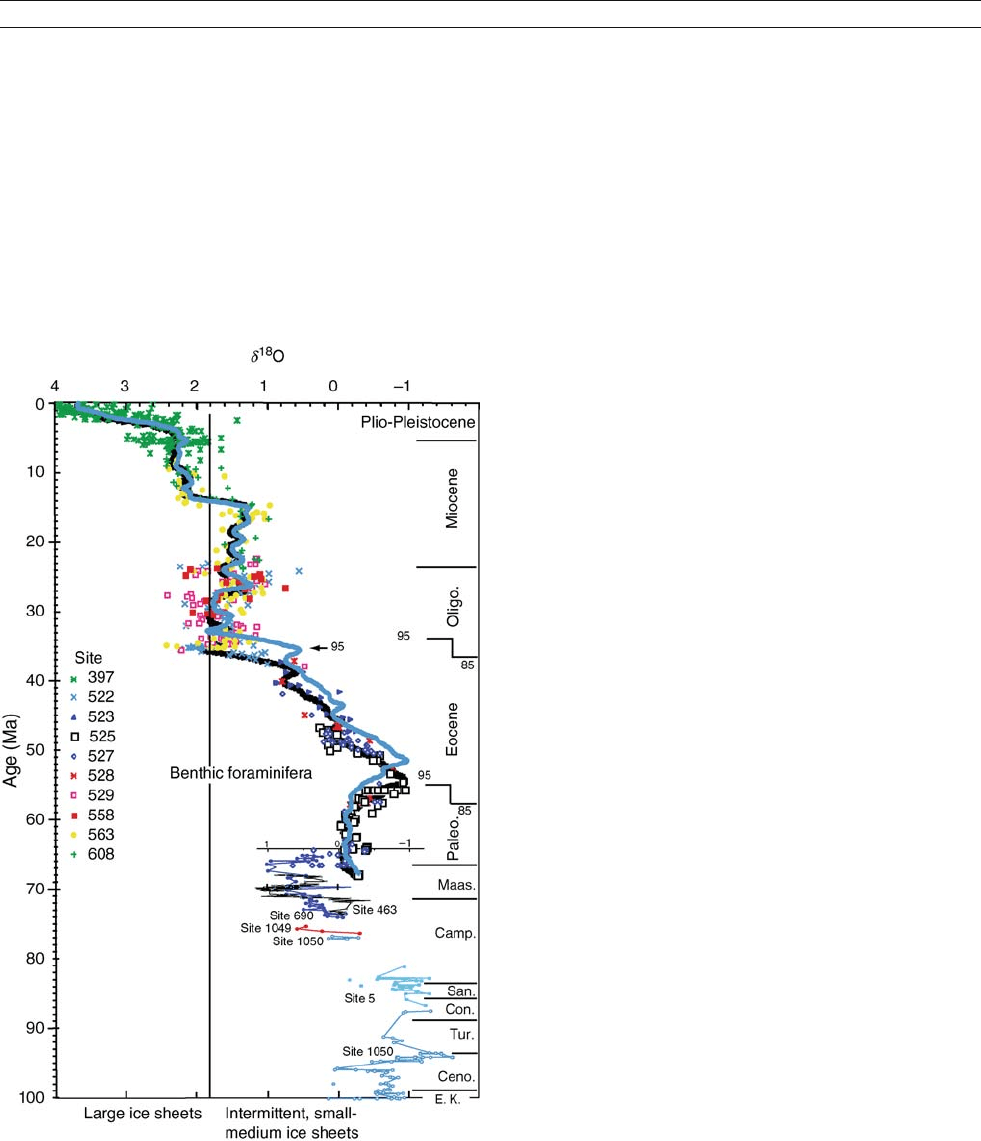
Earth’s temperature, however, is not stable. It is governed
by many external and internal processes operating over different
spatial and temporal scales. Changes in the output of energy by
the Sun, in the seasonal and geographic distribution of insola-
tion due to changes in Earth’s orbital configuration (axial tilt,
precession and the eccentricity of its orbit), and in physical
(wind-blown dust, volcanic emissions) and chemical (radia-
tively-active gas concentrations) characteristics of the atmosphere,
as well as tectonic processes altering the continental distribution
and oceanic circulation, all serve to influence temperature. For
example, the oxygen isotopic record of ocean foraminifera
(Figure P39) provides a vivid picture of the progressive cooling
in climate over the past 100 million years, due mainly to the
influence of long-term changes in ocean basin and continental
configurations, atmospheric composition and other factors (Miller
et al., 1987).
Historical and instrumental temperature records are far too
short to understand these and other complex patterns of Earth’s
temperature variability over different timescales, or to serve as
a baseline against which to evaluate current global tempera-
ture trends and human influence on climate. Therefore, one of
the most actively researched topics in paleoclimatology is the
reconstruction and interpretation of past atmospheric and ocean
temperatures. This entry deals with general aspects of Earth’s
temperature history, mainly atmospheric temperature; see also
Ocean paleotemperatures for methods of estimating oceanic
temperatures.
Methods of paleotemperature reconstruction
Paleoclimatologists use a wide variety of temperature “proxies”
preserved in natural archives such as tree rings, ocean and lake
sediments, glaciers and ice sheets (ice cores), speleothems (preci-
pitated calcite), ancient soils (paleosols), corals and other minera-
lized organisms, and geological and geomorphological features
to estimate past changes in temperature (Table P4). Paleotempera-
ture reconstructions can be qualitative or quantitative, depending
on the proxy method used; however, all methods carry a certain
error bar due to analytical uncertainty, incomplete knowledge of
processes governing organic and biogeochemical systems, and
the influence of factors other than temperature. Uncertainties not-
withstanding, paleotemperature estimates have improved mark-
edly in their accuracy and reliability over the past few decades,
and some of the more important applications to reconstruct past
atmospheric temperatures are discussed here.
Tree rings
The study of tree rings, or dendroclimatology (Fritts, 1976;
Schweingruber, 1988), relies on the influence that temperature
and precipitation have on the growth of trees and is most useful
in the study of climate variability over the past millennium.
Tree rings consist of couplets of alternating light and dark
layers of earlywood and latewood growth, respectively, form-
ing seasonal growth patterns that vary year-to-year depending
on environmental conditions, soil, the age of the tree, and other
factors. Tree ring width, density (a function of several aspects
of cell and wood morphology), and the isotopic (carbon, oxy-
gen and hydrogen) composition of the wood are commonly
used to reconstruct climate history especially in middle to
high latitudes. Summer temperature is a particularly important
influence on latewood density in boreal trees. The success of
dendroclimatology hinges on careful selection of sites and trees,
sophisticated statistical analyses to calibrate tree ring charac-
teristics to climatic parameters, extensive cross-calibration of
multiple trees for chronological control, and an understanding
of the ecology and growth of various tree genera. For example,
ring widths have been used to produce annual temperatures in
northern parts of North America for the past few centuries
(D’Arrigo and Jacoby, 1992). Longer temperature records are
available from carbon isotopes in the case of a 2,000-year
record of temperature developed from conifer trees from the
western United States (Stuiver and Braziunas, 1987).
In recent years, researchers have produced extensive net-
works of tree ring records of temperature and other climate para-
meters such as sea level pressure in North America, Europe, and
Asia (Briffa and Matthews, 2002; Cook et al., 2002), with more
Figure P39 Progressive cooling of global climate is illustrated by
changes in the isotopic composition of foraminifera from deep-sea
cores. More negative d
18
O values characterize the Cretaceous
and Eocene periods of global warmth and minimal polar ice volume;
more positive values during the Oligocene through Quaternary
signify gradual cooling and the build-up of polar ice caps. Modified
from Miller et al. (1987); Cretaceous data from Huber et al. (2002).
Courtesy of Kenneth G. Miller, Rutgers University, Brian Huber,
Smithsonian Institution.
758 PALEOTEMPERATURES AND PROXY RECONSTRUCTIONS

limited data from the Southern Hemisphere. By combining tree
ring data with other temperature proxy records (i.e., ice cores,
lakes) and splicing the proxy records with instrumental records
dating back to the nineteenth century, mean annual hemispheric
and global temperature anomalies and climate variability can be
estimated for the past 2,000 years (Mann and Jones, 2003,
Figure P40). These studies provide convincing evidence that
Northern Hemisphere twentieth century temperatures are among
the warmest in the last 1,000 years, although the density of South-
ern Hemisphere sites is too sparse to make conclusions about that
region. These and other studies also suggest that the interannual
and decadal climate variability during the twentieth century exhi-
bits patterns consistent with the hypothesis that anthropogenic
greenhouse gases have influenced global climate. They also
demonstrate the importance of integrating temperature records
derived from multiple proxy indicators to achieve hemispheric
and global scale atmospheric temperature reconstructions.
Ice core studies of ice sheets and glaciers
Water trapped as ice in glaciers and continental ice sheets pro-
vides a wealth of information on temperature history of high
latitudes and high elevation regions because the isotopic com-
position of the water is heavily dependent on the atmospheric
temperature at time of precipitation. Ice cores from Greenland
and Antarctica recovered paleotemperature records dating back
about 110,000 and 700,000 years, respectively. Of the dozens of
paleoclimate proxies recovered from ice cores, the most widely
used to reconstruct past atmospheric temperatures are the oxygen
(
18
O/
16
O ratio) and hydrogen (deuterium =
2
H) isotopic composi-
tionof the ice. Due to the lower vapor pressures of water molecules
containing heavy isotopes of H (D) and O (
18
O), water condensed
from vapor is preferentially enriched in heavier isotopes. At cooler
temperatures, there is progressively less enrichment in conden-
sation. The relationship between d
18
O of precipitation and atmo-
spheric temperature has been expressed in a number of equations
depending on geographic location and other climatic factors
(Jouzel et al., 1987; Rozanski et al., 1993; Bradley, 1999).
Complications with the
18
O-temperature relationship arise due
to changing moisture source and seasonal variability in precipita-
tion, which can also influence the oxygen isotopic composition
of the water. These processes are particularly important over
longer timescales and researchers must devise means to sort them
out to obtain paleotemperature curves. One approach is to exploit
the relationship between differential fractionation of hydrogen
and oxygen during precipitation, known as the deuterium excess,
or d. During precipitation, a global relationship exists between
hydrogen and oxygen expressed as dD=8d
18
O+10.The
value + 10 represents an offset between the hydrogen and oxygen
Table P4 Summary of methods used to reconstruct atmospheric temperatures
Paleoclimate archive
a
Proxy method for temperature Comments and complications Reference
b
Ice Sheets & Glaciers
(ice cores)
Oxygen and hydrogen isotopes Changes in moisture source and seasonal
precipitation
Jouzel et al. (1997);
Grootes et al. (1993)
Deuterium excess Bradley (1999)
Melt layers Summer only
Lake Sediments and
Peats
Insects (mainly beetles) Elias and Coope (1994)
Fossil pollen Prentice et al. (1991),
Guiot et al. (1989)
Ostracode shell isotopic composition Von Grafenstein et al. (1999)
Ostracode shell trace element
composition
Holmes and Chivas (2002)
Diatoms
Speleothems (stalagtites,
stalagmites, vein
calcite)
Oxygen isotopes Temperature effects during calcite (aragonite)
deposition; composition of regional precipitation
McDermott et al. (2001),
Winograd et al. (1992),
see text
Tree rings
(dendroclimatology)
Ring density and ring width Usually <1,000 years; standardization due to growth Fritts (1976), Schweingruber
(1988)
Carbon, oxygen, hydrogen isotopic
composition
Precipitation and other factors important; complex
hydrological and biological processes during wood
growth
Briffa and Matthews (2002),
Mann et al. (1999),
Mann and Jones (2003)
Geological &
Geomorphological
features
Paleosols (fossil soils) Rainfall has strong influence Retallak (1990)
Glacial sediments High latitudes, elevations
Periglacial sediments Only near glacial margins Washburn (1979)
Lithology & mineralogical
associations
Qualitative Parrish (1998)
Other
Tree lines, elevation
changes
Pollen, macroflora from packrat
middens
Discontinuous, mainly glacial-interglacial timescales Betancourt et al. (1990)
Tree lines, geographic
changes
Pollen Mainly used in Arctic region
Plant macrofossils Plant associations, leaf morphology
a
General Paleoclimatology texts with discussion of paleotemperature reconstruction include Crowley and North (1991), Parrish (1998), Bradley (1999),
Cronin (1999).
b
These are either comprehensive texts on the proxy method or important applications.
PALEOTEMPERATURES AND PROXY RECONSTRUCTIONS 759
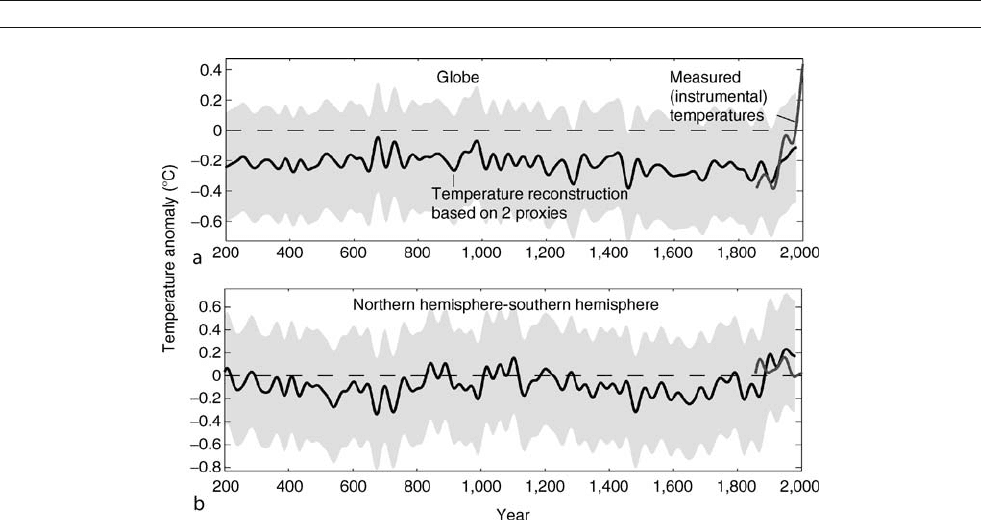
isotopes and is known as d. As atmospheric conditions vary over
time, the value for d also changes and by measuring both d
18
O
and dD in ice cores, a measure of d through time is obtained.
The influence of kinetic processes during both evaporation and
condensation, changing moisture sources and temperature of the
water are complex and need to be sorted out for application of d
to the study of paleotemperature.
Despite these and other complexities, some of the most
important discoveries about Earth’s climate history have come
from oxygen and hydrogen isotopic records from Greenland,
Antarctica, and low latitude alpine glaciers. At the Summit
region of Greenland (mean annual temperature = 31
C), two
large research projects carried out under the auspices of the
European research program called GRIP (Greenland Ice Core
Project), and its American counterpart, GISP II (Greenland Ice
Sheet Project II), have provided excellent isotopic records
of past temperature variability (Dansgaard et al., 1993; Grootes
et al., 1993) that have become a standard against which all late
Quaternary climate records are compared. Figure P41 depicts
the GRIP oxygen isotopic record for the past 100,000 years,
indicating extreme temperature-related isotopic stabi lity during
the Holocene (10,000 years to present) and the existence of more
than 20 millennial-scale climatic oscillations between 100,000
and 15,000 years ago. These events, known as Dansgaard-
Oeschger events, reflect extreme climate instability during the
last glacial period, and they are also recognized in the GISP
II core and many paleoclimate records from around the world.
Since the Greenland ice core isotopic fluctuations were first
described, the interpretation of the temporal variability of the
Greenland d
18
O-temperature relationship has been improved
based on borehole calibration and other means (Cuffey et al.,
1995; Johnsen et al., 1995; Jouzel et al., 1997) and suggest
a glacial to interglacial temperature difference of as much
as 15
C.
Speleothems and precipitated calcite
Speleothems are rocks deposited when calcite or aragonite precipi-
tate from groundwater, often forming stalactites and stalagmites.
Vein calcite is a type of low temperature (34
C) hydrothermal
deposit precipitated from groundwater. Speleothems and vein
calcite, when sampled at fine sub-millimeter-scale intervals, can
yield important paleoclimate information because oxygen fractio-
nation that occurs during deposition of the calcitic rock is depen-
dent on surface temperature. However, precipitation of source
water is itself temperature dependent and also varies due to kinetic
processes, such that the interpretation of speleothem oxygen iso-
tope records must be carried out carefully, on a case-by-case basis.
For example, in an excellent centennial-scale speleothem record
from Ireland, McDermott et al. (2001) were able to detect rapid
climate shifts in the regional climate, which they attributed to both
the effects of temperature and changes in water vapor sources.
In a series of studies of vein calcite at Devils Hole (DH),
Nevada, Winograd, Landwehr and colleagues (Winograd et al.,
1992, 1997; Landwehr et al., 1997; Landwehr and Winograd,
2001) provided an important, but controversial late Quaternary
paleotemperature record reflecting mainly eastern Pacific sea
surface and western United States atmospheric temperatures
(Figure P42). The DH record is unique because, in contrast to
marine records covering the past 400,000 years, DH is directly
dated by the uranium-series methods, and thus yielded a test of
the Milankovitch theory of climate (see Astronomical theory of
climate change). The DH temperature record shows remarkable
Figure P40 Reconstructed and measured global mean temperatures averaged from tree rings, polar and alpine ice cores, and lake and estuarine
sediments for the last 1,800 years. ( a) Reconstructed temperatures combining Northern and Southern Hemisphere records. Alternative temperature
reconstructions based on different weighting methods given in Mann and Jones (2003) and references therein. (b) Hemispheric temperature
difference based on same reconstructed and instrumental temperature curves. From Mann and Jones (2003); Courtesy of Michael E. Mann,
Pennsylvania State University.
760 PALEOTEMPERATURES AND PROXY RECONSTRUCTIONS
